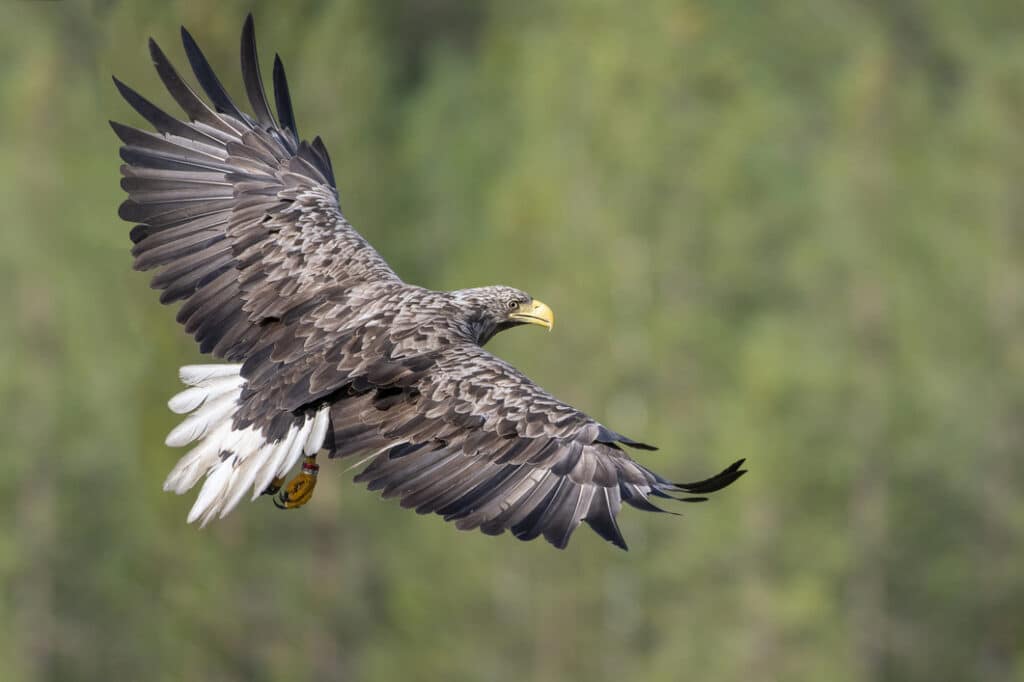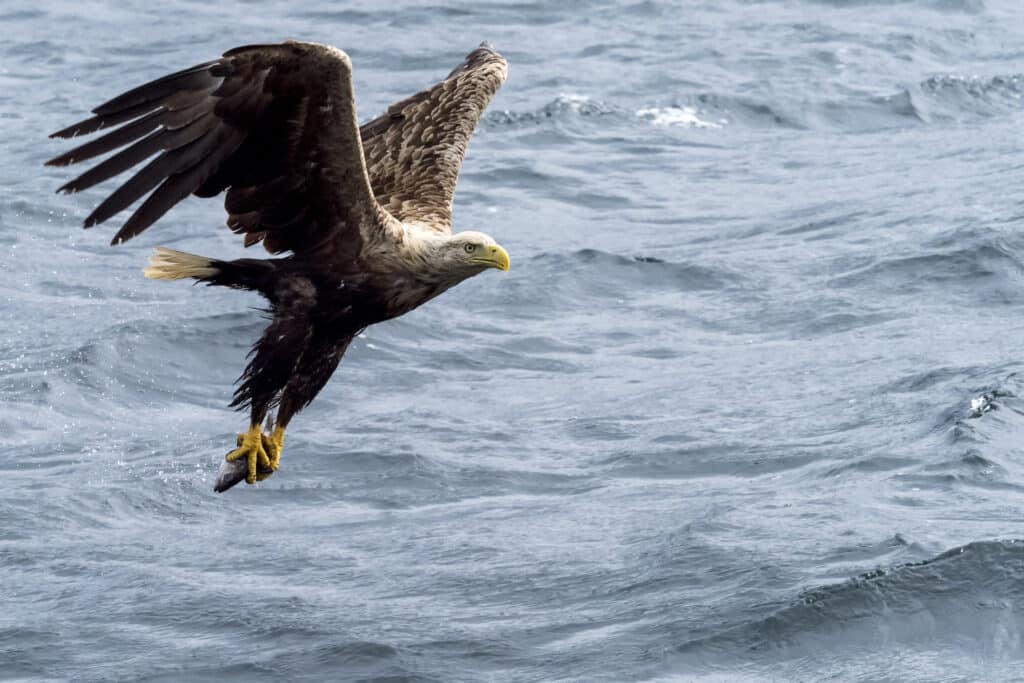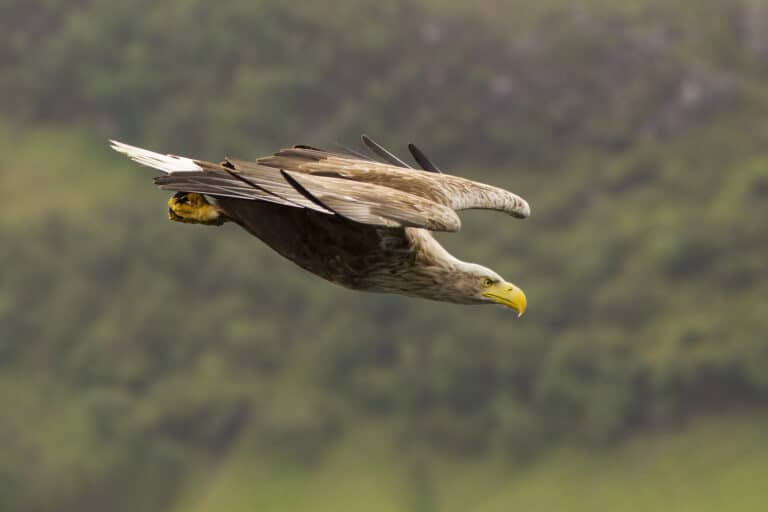Facts about the White-tailed Eagle
Scientific name: Haliaeetus albicilla
Bird Family: Kites, hawks and eagles
UK conservation status: Amber
At a glance
- UK’s largest bird of prey with a massive 2.5m wingspan.
- Largely feeding on fish, White-tails live most of the year near large bodies of open water.
- Thriving in Scotland thanks to reintroductions, but a project in England has seen heavy persecution. A White-tailed Eagle was found shot dead in January 2025 beside Lough Owel, near Mullingar, Co. Westmeath.

The largest UK bird of prey, the wingspan of an adult White-tailed Eagle can reach a massive 2.5m/8ft (some birders fondly refer to the species as ‘flying barn doors’). Opportunistic hunters and carrion feeders, White-tailed Eagles sometimes pirate food from other birds and even otters. They largely eat fish, but also take various birds, rabbits and hares.
Living most of the year near large bodies of open water and requiring an abundant food supply and old-growth trees or ample sea cliffs for nesting, this huge bird is found right across northern Eurasia from as far west as Greenland east to Japan. Often thought of as a coastal species, in, for instance, Germany and Poland, White-tailed Eagles frequent large river valleys, lakes and reservoirs in wooded areas.

Most countries live with White-tails quite happily, but – as so often the case – that’s not been the story here in the UK. Though historically never especially common (these birds are right at the top of the food chain and require huge territories), the species was once widespread across the UK but was heavily persecuted for years by gamekeepers, fishery owners and shepherds, and also suffered from skin and egg collectors. The last known English pair bred on Culver Cliff on the Isle of Wight in 1780. Following its extirpation from Ireland in 1901, White-tailed Eagles were lost entirely to the British Isles in 1918, when the last Scottish bird (a female) was shot in Shetland.
In 1975 a reintroduction programme began to bring this once native raptor back home. Eighty-two young birds from Norwegian nests were brought to Rum between 1975 and 1985 and then more to Wester Ross between 1993 and 1998. The first chick from the programme fledged in 1985 when a pair bred successfully on the Isle of Mull. A 2019 report concluded that visitors to Mull spend between £4.9 million and £8 million every year coming to see the now established and thriving population of White-tailed Eagles.
There are now more than 130 territorial pairs in Scotland, but old habits apparently die hard and at least seven White-tailed Eagles have been killed illegally since the start of the project and at least four clutches of eggs have been stolen. In 2011 the Scottish Gamekeeper’s Association (SGA) were widely ridiculed for apparently writing to the Scottish Environment Minister repeating myths from a century ago by asking: “Will these very large creatures differentiate between a small child and more natural quarry?” RSPB Scotland tweeted appropriately: “Alarmist nonsense from the SGA.“
There have been attempts to reintroduce birds to England too, where plenty of suitable habitat remains.
Earlier projects were stymied by a coalition of sheep farmers and shooters. A plan to reintroduce eagles to Suffolk in 2007, for example, was eventually dropped in 2010. A well-known shooting industry magazine reported that the scheme was “opposed by local farmers and shoot owners who fear the bird’s reintroduction could damage their livelihoods. Earlier this year a group of farmers, shooters and landowners made their views clear by erecting protest signs on local roads”.

Despite the archaic attitudes of some ‘rural communities’ and lobbyists, progress was finally made when a widely reported reintroduction programme, led by the Roy Dennis Wildlife Foundation, translocated juvenile White-tailed Eagles collected under licence from nests in Scotland to the Isle of Wight in late June 2019.
By 2022, twenty-five young birds had been released on the Isle of Wight and (as expected) had started to wander along the south coast. They won’t breed until they are more mature though – if they are allowed to live long enough. Frustratingly, in early 2022 two of the reintroduced birds were found dead, both on unnamed shooting estates. One, in Sussex, had been shot, the other, in Dorset, had been poisoned.
While universal disappointment and dismay was expressed by conservationists and local residents, Dorset West Conservative MP Chris Loder, a landowner and farmer, took to social media instead with a tweet that appeared to tell police not to investigate what was a serious wildlife crime, saying (wrongly) that in his opinion ‘Eagles don’t belong in Dorset’.
Loder also triumphantly posted another tweet with a photo showing what appeared to be a White-tailed Eagle carrying off a lamb, only to be told almost immediately by the photographer that two photos had been staged for a separate project: this was in fact a captive eagle posed with an already dead lamb.
